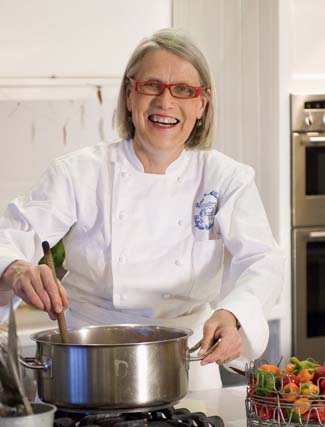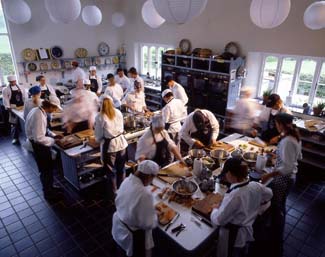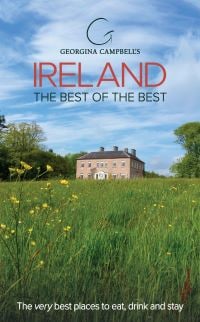The Darina Allen Column
 This month Darina fondly remembers one of Kerry’s most legendary women - and one of its greatest cooks - the late Mary Keane
This month Darina fondly remembers one of Kerry’s most legendary women - and one of its greatest cooks - the late Mary Keane
I recently heard the sad news of Mary Keane’s passing. Mary was often referred to as John B Keane’s wife, as indeed she was for 47 years until his death in 2002, but Mary was a legend in herself. I only met her a couple of times but each encounter imprinted itself on my mind and I felt so fortunate that our paths had crossed.
Mary had a wonderful way with words, I loved the colloquial language she used and how she seemed so totally happy and confident in her own self and place. You might say, Well of course, but it was an extra intangible something that was both inspirational and endearing and a rare enough quality.
In 2009 I had a wonderful morning with Mary learning how to make traditional Listowel Mutton Pies. I was in the town for the annual Food Fair and of course strayed into the legendary family pub, I fell into lively company and we took to discussing food.
Local butcher turned bookie, Eric Brown regaled me with stories of the beef and kidney stew and the hare soup his mother used to make after the local coursing meeting. He taught me a new technique of skinning rabbits and slipped me a few tips for the next race meeting. Then who should come to the scene but the matriarch of the Keane dynasty, the doyenne of mutton pies herself, she being the winner of the Listowel Mutton pie competition in 2007, an accolade she was very proud of.
A spirited exchange took place between Mary, her son Billy, Jimmy Deenihan and several other punters about the traditional mutton pie. It was wonderful stuff, everyone had an opinion but what was most thrilling for me was the discovery that the pie tradition is still alive and well in Listowel, Co Kerry. I wished I’d had a video camera to record this exchange.
I was still thinking about it when I woke the following morning, so on impulse I picked up the phone and asked Mary to show me herself - I thought the worst she could do was say no if it didn’t suit her. She was still in ‘her nightdress’ and hadn’t even had a cup of tea when I rang but she said she’d do her best to find someone to stand behind the bar while she ran out to the butcher to get some mutton. “I have the self raising flour and the margarine but I’ll need a drop of buttermilk.”
We met in the little kitchen behind the pub around 11am. All the ingredients, plus salt, ground white pepper and a rolling pin were laid out on the table. Mary had already started to chop and was sharpening a knife on a fragment of whet stone as I arrived. She put me to work right away. “Cut the meat cut into tiny cubes, not more than 1/8 of an inch.” There was a mixture of shoulder, lap and shank in what we had. The chopped meat went into a green Tupperware bowl and was seasoned liberally with salt and finely ground white pepper.
Next the pastry. Mary put about 1½ lbs of self raising flour into a bowl, a pinch of salt and enough buttermilk to mix. It was more like a bread dough really than a pastry. Mary gathered it all together, then kneaded it for a minute or two, before rolling out to a thickness of about ¼ inch with the wooden rolling pin. Then she took a saucer out of the cupboard and used it as a template to cut out rounds of dough.
Mary was taught how to make traditional pies by her mother in law, Hannah Purtill a member of Cumann na mBan, who lived in a house in Church Street. One at a time each circle of dough was rolled into a thinner round. Mary put a generous half fistful of mutton into the centre, brushed the edges with buttermilk and then pressed another round onto the top, the edges were pressed together to seal and then pricked with a fork 4 or 5 times. By now the oven had been preheated to 230°C (450ºF) so the pies were baked 3 or 4 at a time on a baking tray – we made 8 in all.
According to Mary, the tradition of pie making in Listowel came about because the women wanted to go to the races, they didn’t want to be deprived of their fun so they made a ‘blast of pies’ a few days before the famous Listowel races. The way Listowel mutton pies are eaten is unique. The pastry is quite robust because of the small proportion of shortening to flour, not at all fragile.
A big pot of mutton broth is made from the bones with maybe an onion or two added. On race day, the pies are slipped, a couple at a time into the pot of strained broth. They simmer away gently for 15 or 20 minutes and are then served into wide shallow soup bowls with a ladle full of hot broth on top. They are eaten with a spoon and a fork and some extra salt and pepper if you like.
Mary told me that her pies were never quite right for John B, “he was always cribbing that the pastry was always a bit too thick or too thin, not like his mothers”. So eventually she said, “Well you can try your hand at it yourself.” So for a whole day before race week in Listowel, in the little kitchen behind the pub, ‘I’d put a bib on him’ and we’d cut up the meat for the pies to have a supply for the pub for race week’. Can you imagine the chat and banter while the two of them made pies together? Wish I’d been a fly on the wall.
Listowel Mutton Pies
Despite the fact that mutton is having a terrific revival in the UK it is still very difficult to find mutton in Ireland so use hogget instead (the name for more mature lamb between Christmas and Easter.) Makes 8
450g (1lb) mutton or hogget - a mixture of neck, shank and scrag end buy a bit more to allow for trimming.
lots of salt and ground white pepper
Pastry
900g (2lb) white flour
½ teaspoon salt
110g (1/4lb) Stork margarine or butter
850ml (1½ pints) buttermilk
Mutton Broth
2-2.5kg (4-6lb) mutton or hogget bones approximately
3-4 large onions, peeled and quartered
a couple of carrots, stalks of celery, parsley stalks, a couple of sprigs of thyme and pepper. OR a stock cube, which Mary occasionally uses.
First prepare the lamb. Trim off the fat and any gristle or membrane. Cut into tiny pieces (roughly 1/8 inch) and put into a shallow bowl. Season well with salt and ground white pepper (the kind that comes in a little cardboard shaker). Toss to make sure the meat is evenly coated.
Then, make the pastry. Put the flour into a bowl. Rub in the margarine or butter, add the buttermilk and mix with your hand to a firm dough, similar though drier than the texture of white soda bread. Mary kneaded the dough for 30 seconds to 1 minute to firm it up. Divide into two pieces.
On a floured board, roll the pastry out as thinly as possible, to about 5mm (¼ inch). Mary used a saucer as a template and cut out 8 circles. Take one round and roll it out a little further to thin the pastry to approximately 2-3mm (1/8 inch).
Put a good half fistful of seasoned mutton or hogget into the centre. Brush the edge of the pastry with a little buttermilk and cover with another round that has also been rolled to 1/8-inch thickness. Press the edges together with the tines of a fork, then prick the top several times.
Preheat the oven to 230ºC/450ºF/gas mark 8. Meanwhile, continue to make the remainder of the pies. When the first four are ready, cook on a baking tray in the preheated oven for 20-30 minutes. Check occasionally and reverse the tray from back to front if necessary.
Meanwhile, continue to make the pies until all the pastry and filling is used up. Cool the pies on a wire rack. At this point, they can be kept wrapped for several days or frozen for later use.
Meanwhile make a simple mutton stock.
Put the mutton or hogget bones into a deep saucepan, add a couple of peeled chopped onions, cover with cold water, bring to the boil, cover and simmer for 1-1½ hours. Strain. Mary said she adds a couple of stock cubes to add extra flavour but if you would rather not, I suggest adding a few thickly sliced carrots and a few sticks of celery, a sprig or two of thyme, some parsley stalks and maybe a sliced white turnip, if available, to add extra flavour to the broth. Strain and taste, add salt and pepper to correct the seasoning. Save until needed. The broth will keep in a fridge for several days or may be frozen.
To serve the mutton pies - bring the broth to the boil in a deep saucepan, drop a couple of meat pies into the broth. Simmer for 20 minutes. Remove with a slotted spoon. Transfer each pie into a wide shallow soup bowl. Pour a ladle of mutton broth on top. Eat with a fork and spoon and extra pepper and salt, depending on your taste.
'30 Years at Ballymaloe' - Bord Gáis Avonmore Cookbook of the Year 2013
Good Food Ireland Cookery School of the Year 2012/2013
***
 Once again, the Ballymaloe Cookery School in East Cork has a great programme of cookery courses for all interests and abilities running throughout 2015. Ranging from a relaxing visit to sit in on an afternoon cookery demonstration to a week long ‘Intensive Introductory Course’.
Once again, the Ballymaloe Cookery School in East Cork has a great programme of cookery courses for all interests and abilities running throughout 2015. Ranging from a relaxing visit to sit in on an afternoon cookery demonstration to a week long ‘Intensive Introductory Course’.
Sitting in the middle of a 100 acre organic farm the Ballymaloe Cookery School provides its students not only with a life skill learnt under the expert tutelage of their very capable teachers but also a place to relax and unwind from the stresses and strains of normal everyday life. The cottage accommodation available onsite for residential courses consists of a collection of delightful converted outbuildings which have been transformed over the years by the Allens, and other accommodation is available locally for the short courses.
www.cookingisfun.ie






There are currently no comments
Leave a comment
Not a member? Register for your free membership now!
Or leave a comment by logging in with: